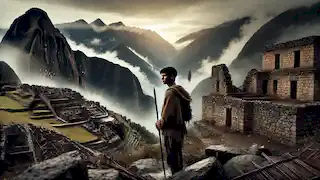The Tale of the Chachapoya Cloud Warriors
Reading time: 10 min
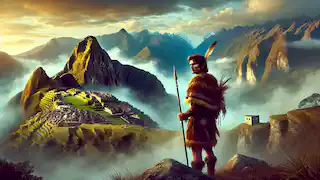
About this story: The Tale of the Chachapoya Cloud Warriors is a Historical Fiction from Peru set in the Medieval This Dramatic tale explores themes of Courage and is suitable for Adults. It offers Historical insights. A battle of courage and survival against the Inca Empire in the misty highlands of Peru.
Lost in the Mists of Time
In the towering mountains of Peru, where clouds hang low and the air is thick with the scent of earth, lived a people so mysterious that their name alone evokes images of warriors standing amidst the mist. These were the Chachapoya, the "Cloud Warriors," who carved out a life in one of the most remote and rugged landscapes in the world. While the Inca Empire rose to prominence in the valleys below, the Chachapoya thrived in the highlands, defending their territory fiercely against invaders. Their legacy, shrouded in myth and obscured by time, tells the tale of a people whose warriors seemed to be made of the clouds themselves.
This is their story, a story of courage, resilience, and a civilization that, though lost to history, continues to leave traces in the enigmatic ruins scattered across the Andes.
The Call of the Highlands
The clouds drifted over the jagged peaks of the Andes, casting fleeting shadows across the valley. In the distance, the soaring cliffs of Kuélap loomed, the citadel of the Chachapoya. It was here, amid the high altitude forests and cloud-covered slopes, that these fierce warriors made their home.
Huari, a young warrior of the Chachapoya tribe, stood at the edge of a cliff, watching the clouds roll in below. His heart beat in rhythm with the wind, the blood of his ancestors pulsing through his veins. He had trained for years, like all Chachapoya youth, learning the ways of combat, strategy, and survival in the most unforgiving terrain.
Yet today felt different.
A strange unease had settled over the region. Reports had come from the lower valleys of a growing threat — the Inca Empire. For centuries, the Chachapoya had remained relatively isolated, their mountain fortress protecting them from outside invasion. But now, the empire that was rapidly expanding to the west was starting to set its sights on their lands.
Huari turned as he heard footsteps approaching. His father, Cota, a seasoned warrior and one of the tribe's most respected leaders, stepped up beside him.
"Do you feel it?" Cota asked, his voice low and grave. "The clouds speak of war."
Huari nodded. "The Incas grow bold. They come for the valleys first, but soon they will march for our mountains."
Cota's eyes were dark with worry, though his expression remained as steady as the stone beneath their feet. "We have fought to protect our land for generations. And we will do it again."
With a firm pat on Huari's shoulder, Cota gestured for him to follow. They made their way back to the citadel, where the council of elders was assembling. The air inside Kuélap’s stone walls was tense with anticipation. The Chachapoya were not a people who bowed easily to fear, but the threat of the Incas was one they could not take lightly.
As they entered the council hall, the elders turned their attention to Cota, who, as the chief warrior, held great sway in the decision-making process.
"The Incas have begun their conquest of the valleys below," Cota began, his voice steady. "It is only a matter of time before they come for us. We must prepare."
The elders murmured in agreement, but there was concern etched on their faces. The Incas were known not only for their formidable military strength but also for their ability to assimilate other cultures into their empire through diplomacy and force alike.
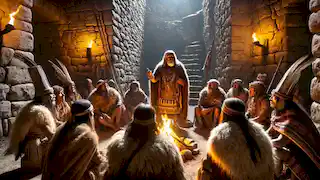
The Rise of the Incas
Down in the lush, fertile valleys below the mountains, the Inca Empire was growing rapidly. The Sapa Inca, Pachacuti, was a man of great ambition, a ruler determined to unite the scattered peoples of the Andes under one empire. His strategy was as much political as it was military, but when diplomacy failed, his armies marched forward relentlessly.
For years, the Chachapoya had watched from the highlands as the Incas expanded their reach, swallowing up smaller tribes and fortifying their position. But now, the expansion had reached the very edges of Chachapoya territory, and it was clear that a confrontation was inevitable.
Huari had grown up hearing stories of the Inca warriors, their disciplined ranks and the powerful slings they wielded with deadly precision. He had even seen some of their scouts in the distance, their bright tunics visible against the green of the valley below. But he had never faced them in battle.
"Father," Huari said as they prepared for the council meeting, "if the Incas attack, will we be able to defend our lands?"
Cota paused, looking at his son with a mix of pride and concern. "The Chachapoya have always defended what is ours. We know the mountains better than anyone. The Incas may be powerful, but we have the advantage of the terrain."
But Huari could sense the uncertainty in his father's voice. The Incas were not just any enemy — they were an empire, vast and well-organized. They had more men, more weapons, and more resources than the Chachapoya could ever hope to match. And yet, the Chachapoya had something the Incas did not — the knowledge of the land, and the determination to protect their homes at any cost.
The council gathered that evening to discuss their strategy. The elders debated long into the night, weighing their options. Some advocated for diplomacy, for trying to broker a peace with the Incas before the situation escalated into all-out war. Others, like Cota, believed that the only way to preserve their independence was to fight.
"We are the Cloud Warriors," Cota said, his voice firm. "Our people have lived in these mountains for centuries. We have defended them from every threat that has come our way, and we will defend them again. The Incas may be powerful, but they will find no easy victory here."
After much deliberation, the council agreed. They would prepare for war.
The War Begins
The Inca emissary arrived at Kuélap a few weeks later, his bright red and gold tunic marking him as a representative of the Sapa Inca himself. He was flanked by two Inca warriors, their faces stern and unreadable.
The emissary stood before the council, his voice echoing in the great stone hall. "The Sapa Inca sends greetings to the people of the Chachapoya. He invites you to join the Inca Empire, to become part of a great and prosperous nation. In return, he offers protection and peace."
The room fell silent as the elders listened. Huari, standing beside his father, could feel the tension rising. The offer was tempting — the Incas were powerful, and joining them would mean security for the Chachapoya people. But it would also mean losing their independence, their identity.
Cota stood, his eyes fixed on the emissary. "We are grateful for the Sapa Inca's offer," he said, his voice calm but firm. "But the Chachapoya are a free people. We have lived in these mountains for generations, and we will not surrender our freedom so easily."
The emissary's expression remained neutral, but Huari could see a flicker of something in his eyes — disappointment, perhaps, or anger. "The Sapa Inca does not take rejection lightly," the emissary warned. "If you refuse his offer, the consequences will be severe."
Cota's gaze did not waver. "We are prepared to defend our land."
The emissary nodded curtly and turned to leave, his warriors following behind him. As they disappeared into the mist, the tension in the room broke, replaced by a grim determination. The Chachapoya had made their choice.
The First Skirmishes
The Inca invasion came swiftly.
Over the next few months, the Incas began their campaign against the Chachapoya. They started by attacking the villages in the lower valleys, burning homes and capturing prisoners. The Chachapoya warriors, led by Cota and Huari, fought fiercely, using their knowledge of the terrain to their advantage.
The steep, narrow mountain paths proved to be a formidable obstacle for the Inca forces. The Chachapoya warriors would strike from the shadows, ambushing the Inca troops and then disappearing into the mist before they could retaliate. It was a guerrilla war, fought in the dense forests and high cliffs of the Andes, where the Chachapoya knew every stone and tree.
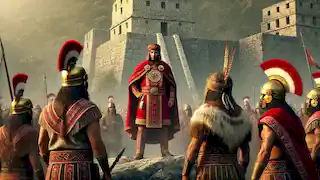
The Siege of Kuélap
Despite the Chachapoya’s resilience, the Incas were relentless. Their numbers were vast, and they slowly began to push the Chachapoya back toward their mountain stronghold. The siege of Kuélap was inevitable.
As the Inca forces gathered at the base of the mountain, Huari stood at the top of the citadel, looking down at the enemy below. His heart was heavy, but his resolve was unshaken. This was their home, their last stand. They would not give it up without a fight.
"Father," Huari said quietly, "no matter what happens, we must make them remember that the Chachapoya will not be easily broken."
Cota nodded, his expression grim. "We will make them remember."
The battle for Kuélap lasted for days, the Chachapoya warriors fighting with all the strength they had. They used every advantage the terrain offered, launching rocks and arrows from the heights, engaging the Incas in brutal hand-to-hand combat when they breached
the walls.
But the Incas were relentless. Slowly, they began to gain ground, their superior numbers overwhelming the Chachapoya defenders. Huari fought alongside his father, his muscles burning with exhaustion, but he refused to give in.
In the final hours of the battle, as the Incas pressed their attack, Cota was struck down. Huari rushed to his side, his heart breaking as he knelt beside his father.
"Father," Huari whispered, his voice choked with emotion.
Cota looked up at his son, his breathing ragged. "You must carry on," he said weakly. "The Chachapoya are not finished yet. We will live on — through you."
With those final words, Cota closed his eyes, his body still.
Huari's grief was overwhelming, but he had no time to mourn. The battle was not yet over, and his people still needed him.
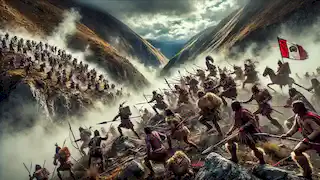
The Legacy of the Cloud Warriors
In the end, the Incas took Kuélap, but the Chachapoya were not defeated. Though their fortress had fallen, their spirit remained unbroken. Huari and the surviving warriors retreated into the mountains, where they continued to resist the Inca forces, striking from the shadows like ghosts in the mist.
The Chachapoya may have lost their citadel, but they had not lost their identity. They remained the Cloud Warriors, defenders of the highlands, guardians of the mist.
As Huari stood on a distant peak, watching the clouds roll in over the mountains, he knew that his father's words were true. The Chachapoya would live on, their legacy carried in the hearts of those who refused to give up the fight.
And so, the tale of the Chachapoya Cloud Warriors became legend, a story passed down through the generations, a reminder of a people who stood tall in the face of an empire, their spirits as unyielding as the mountains they called home.
Conclusion: Echoes in the Mist
Though the Chachapoya were eventually absorbed into the Inca Empire, their legacy as fierce warriors and defenders of their homeland lived on. The ruins of Kuélap, perched high in the Andes, still stand today, a testament to the strength and resilience of a people who fought to the very end to protect their way of life.
In the swirling mists of the Andes, the spirits of the Cloud Warriors still roam, their story a reminder that even in the face of overwhelming odds, the human spirit can endure.
